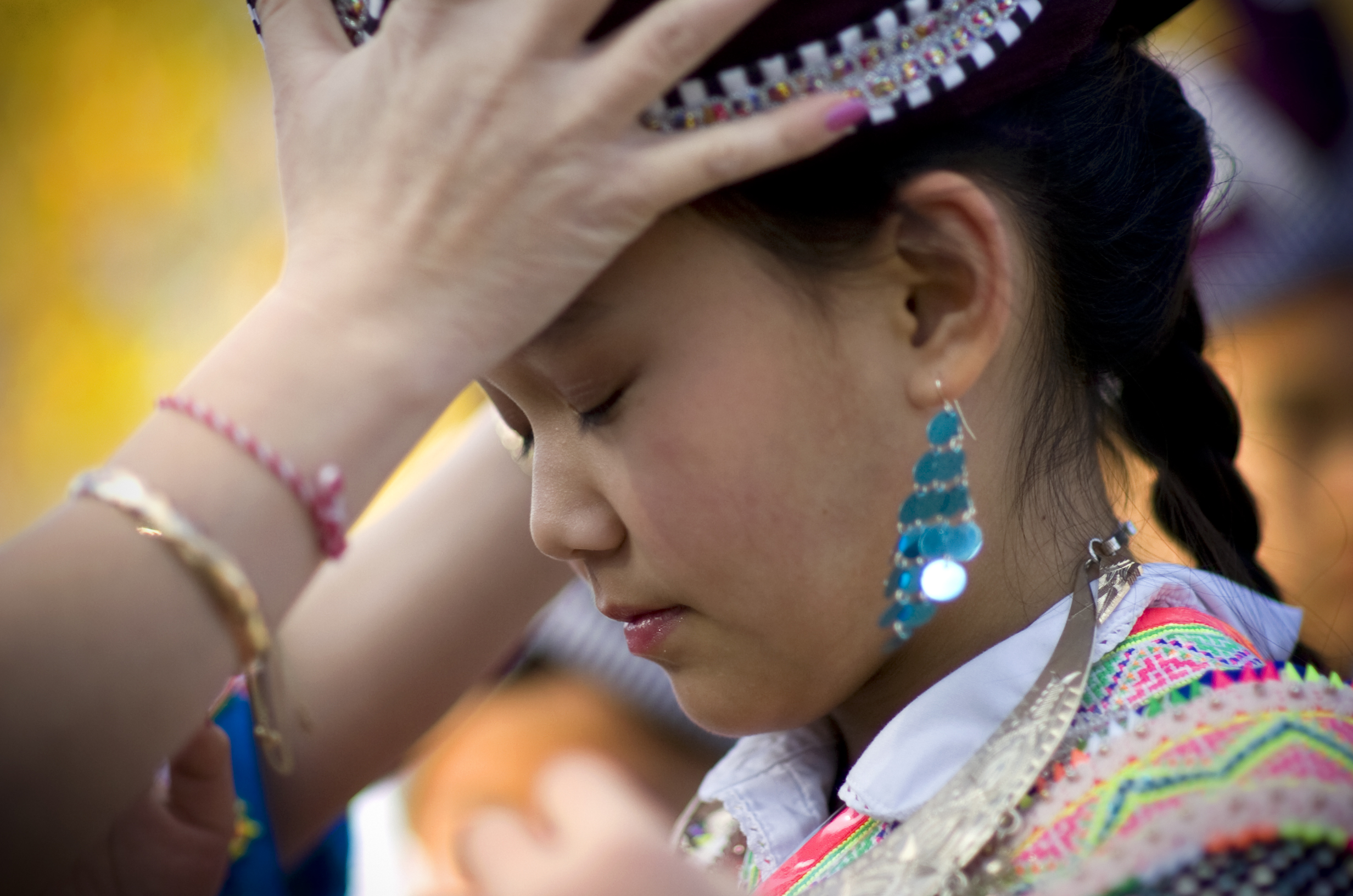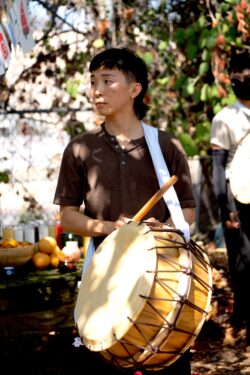
This summer, in honor of LGBTQ Pride and Disability Pride Months, we’re proud to feature Haejin Bang (they/he) — Director of Cultural Arts & Base Building at the Beverly-Vermont Community Land Trust (BVCLT) in Koreatown, Los Angeles, a 2024-2025 Living Cultures Grant recipient. Born and raised on Tongva land, the Koreatown native’s practice draws on pansori 판소리—a traditional Korean storytelling form involving voice and drumming—as well as community gardening, tenant organizing, and land-based workshops that center care, voice, and access. As Haejin says, “All the work I do is based around home.”
At first glance, traditional arts and community organizing might seem like separate realms—one tied to heritage, the other to housing, policy, and power. But as Haejin’s work makes clear, that’s a false dichotomy. Traditional arts have always been ways of gathering and making meaning together. As Haejin reminds us, practices like pansori were never meant to be preserved in isolation—they are embodied, land-based, and communal. In Koreatown, where both cultural and green space are scarce, Haejin is helping to build something rooted and restorative. Their work brings together older immigrants, unhoused neighbors, and queer and disabled folks—through voice, music, and stories.
In this conversation, Haejin reflects on what it means to find one’s voice, tend to land, and build cultural spaces rooted in joy and freedom.
Can you give us a brief introduction to you and your practice?
My name is Haejin Bang. My main practice is pansori, which is a form of storytelling that’s told through a singer and a drummer. It’s a storytelling practice in which the singer tells a story through narration, singing, and different movements on stage, which we overall call sori /소리, which means “sound.” The drummer is the accompanist, helping support the singer in the telling of the story. They also play the soribuk (소리북), which is a barrel drum. There’s a sort of call and response relationship between the singer and the drummer. I practice both, which I feel are equal in the practice of pansori. I’ve been learning for nearly seven to eight years now, going back and forth between L.A. and Korea and situating myself in this practice.
Looking into the history and the embodiment of the practice, pansori is deeply rooted in trans-ness—in finding your own voice, in being connected to your own body, and in being connected with land.
I was drawn to this practice in the first place because of my experiences as a trans diasporic Corean*. I knew I wanted to be connected to a practice that was tied to my body and to land in a way that felt real, connected to my own ancestry and my own story. That’s how I fell into pansori. I was hearing it live for the first time and being connected to folks in Korea who are big culture bearers back in the motherland. Also, looking into the history and the embodiment of the practice, it is deeply rooted in trans-ness—in finding your own voice, in being connected to your own body, and being connected with land. It’s a very land-based spiritual practice. These are all things that inform my relationship to pansori and also inform my relationship to Korea and to folk and indigenous Corean practices in general, not just pansori, but also pungmul, for example. Pungmul is another communal drumming practice I do alongside other queer trans diasporic folks here in the U.S.
How do you situate your practice in this politically turbulent moment?
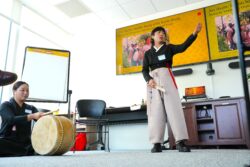
It’s a really tricky question and something I’ve been trying to figure out, being disabled with everything happening in the world, especially in L.A. where I’m rooted. Pansori is one of these practices that most diasporic—especially trans and disabled folks—don’t have access to. It’s become a very institutionalized practice and that’s something that feels really complicated for me. Part of my work and my goal with this practice is to make it more accessible for diasporic folks—specifically Corean trans disabled folks—who want to engage with pansori but don’t have the means or access. I have firsthand felt the inaccessibility of this practice—being disabled, having to go to Korea to learn, trying to get institutional access to learn, not being able to be in those spaces because of how disabled I am, being trans and having to be stealth about it. All of that shapes how I understand pansori.
As a trans disabled person, as a diaspora Corean, how can I find my voice? How can I root myself in this practice and share it with others who want to learn?
In a sense, I’m really grounding myself in the roots of the practice instead of how institutionalized it’s become, especially with the Korean government utilizing traditional arts as a cultural product. My intention has always been to move away from that and really go back to the land base and spiritual roots. Pansori comes from shamanic songs and practices, and there’s an inherent transness to that—Corean shamanism is gender fluid and trans in nature. That’s always been a part of it: as a trans disabled person, as a diaspora Corean, how can I find my voice? How can I root myself in this practice and share it with others who want to learn?
How did traditional corean art forms become part of your organizing and artistic practice—especially in a place like Koreatown?
I was born and raised in Koreatown. It’s always been home, and my experiences growing up here—working class, housing unstable, houseless at times—shape everything I do. These experiences tie into the housing justice work I do with the Beverly-Vermont Community Land Trust: it’s about keeping folks in their homes, especially those who have lived here for years and have deep roots in Koreatown and central LA.
I knew that this was work that I needed to do and that I wanted to do. It’s been a mix of tenant organizing and creative cultural work. The question has always been: how do we bring these two pieces together in a way that feels good and not forced? I’ve been figuring that out as BVCLT’s cultural arts and base building person. Koreatown is known for its lack of green space. We only have one tiny park in the whole neighborhood, so having a community garden where folks can gather and plug in is huge. A big part of the work I do is: how do we reconnect to land?
Pansori is a land-based, storytelling practice meant to ground us in and with the land we inhabit.
That ties to pansori as well. It’s a land-based, storytelling practice meant to ground us in and with the land we inhabit. How can we tie all of that together? How can we tell our stories in a way that feels embodied and good? This all goes back to the question of culture and art, and why it is important. It isn’t superfluous, like “oh, we’re just doing this for fun.” We know we need joy. We need to be telling our stories. We need every tool we can get to feel grounded. Especially now, when we’re hyper-vigilant all the time, and especially for folks who are housing insecure, always on edge and in survival mode. How do we move out of that and into connection with ourselves and with community? That’s a huge chunk of the work that I do. Pansori is a big part of that.
What are your hopes and goals for the upcoming Koreatown Pansori Block Party project?
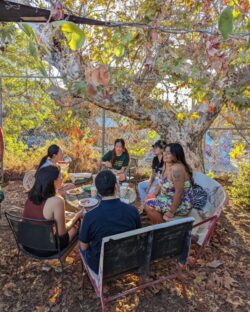
I’ve been rooting a lot of my programming and base-building work in the garden. Last year, we started with an autumn equinox event—a daylong gathering with workshops and activities. The main goal was to get people to know that there was a garden there, and also for everyone to get to know their neighbors. We had activities that were tied to the garden, to tending land with our bodies. People ended up being really invested and interested in those kinds of events. We brought a lot of people together that wouldn’t normally be there. A huge chunk of our work is multiracial building in Koreatown, just because we are so ethnically segregated, like all of L.A. Especially now, with ICE raids and everything else happening, we’re asking: how can we support each other and get to know our neighbors?
We’ve been continuing to hold free events for folks, and our goal with the block party has been to continue that work and find moments of restorative joy and rest—cementing that these things are important and necessary in order for us to move, build, and grow together. Care is a big part of the work that I feel is really important. I’m trying to move at a pace that’s sustainable for all of us—not just for the work we do at the Community Land Trust, but for the people in our communities, with the people we engage with, our friends and our families, especially because all of the folks at the Land Trust are from Central L.A. or live here.
Culture and art isn’t superfluous, like “oh, we’re just doing this for fun.” We know we need joy. We need to be telling our stories.
Merging these threads—arts, organizing, access—has been a big experiment. It’s not common to find somebody doing cultural arts organizing in community land trusts or housing justice spaces. We know this is important, but how can we really merge all of this work together in a way that feels cohesive and good?
In what ways has your experience as a disabled and trans artist shaped how you think about sound, silence, and listening in your practice?
The reason why I was drawn to pansori as a disabled person was because it’s a somatic practice. It’s storytelling in the straightforward sense: narrating and telling a story verbally. But also, there’s a part of pansori—not just with the drumming, but with the voicing—that moves beyond language. A lot of that embodiment is stored in the timbre of the voice and how you embody your voice. The whole process of learning pansori is about learning the stories, but also about finding your voice. In Korean, you say finding your sori.
As a trans person who is transitioning, my voice is changing; the way my voice is in my body is changing all the time. My practice speaks to my experience with trauma—trauma being stored in the body—and using pansori as a way to assess how trauma inflects my voice or lack of voice. Drumming is also a non-verbal practice, but both voice and drum are rooted in breath. That’s a big part of pansori—finding your breath. There are ties to traditional Corean medicine and how we perceive energy, moving away from Western constructs of body and health.
The whole process of learning pansori is about learning the stories, but also about finding your voice. In Korean, you say finding your sori.
It’s been a way for me—and for other diasporic disabled folks—to figure out our relationships to our bodies in a way that isn’t pathologized. It’s also been a way to translate that for queer, trans, and BIPOC folks who want to feel more connected to their bodies or to find their voice, starting with the basics of pansori vocalization.
Pansori is a regional practice; each region has its own dialect and core sounds. I use this concept of core sound and translate it to our own bodies. How can we find the core sounds that resonate with us? How does that ground us? How can that tie into the drum? These are questions I ask myself when doing workshops around pansori. What stories can our bodies tell us about our relationship to the land? Can we examine our bodies through voice and drum? That’s a huge piece of the practice’s queerness, its transness, and how it can be accessible. But it has to go back to its roots. This potential for it to be a truly communal practice is why people are drawn to pansori in the first place.
What stories can our bodies tell us about our relationship to the land? Can we examine our bodies through voice and drum?
The garden is tied to that too. A lot of our work isn’t just around pansori. I’ve been facilitating workshops around land and body. One is a paper-making workshop using plant fibers from the garden. We go through the process of drying the stems, beating them with hammers, mashing the fiber, flattening it, and drying it again. I had no connection to land growing up in Koreatown, in a gardening sense. I didn’t have knowledge about plants and soil because I didn’t have access to it. We’re thinking about how to recreate relationships to land—how to use what we have at the garden to connect to our bodies, to ourselves, to other people who are also tending to the garden, and to land.
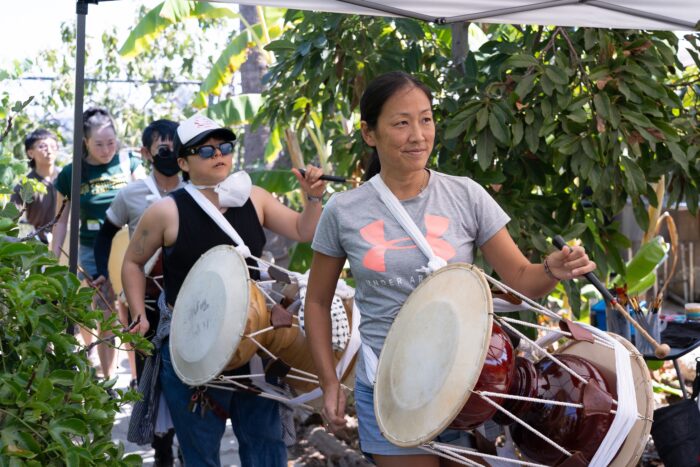
What role do you think traditional arts can play in the lives of queer, trans, or disabled people—not just in terms of representation, but in shaping how we gather, heal, and build community?
At a base level, it’s about access—bringing the tenets of disability justice into everything we do. That means centering folks who aren’t always able to make it to events, including older immigrants and people who may not identify as disabled but still face barriers. We always center language justice: we always have interpreters. That’s just something we always have and we know we will always need. We make sure there’s access information for every event. We ask what folks’ needs are, we check in with everyone before and after every event. It’s a lot of things that, being in disability justice spaces, are normalized for me: we just check in with each other all the time. PPE, COVID care—that’s always gonna be there. Food, refreshments—that’s always going to be there. Our goal is always to make our events free. People should not have to pay to do things that bring them joy. These are all the things that we’re constantly thinking about and constantly reassessing.
People should not have to pay to do things that bring them joy.
In closing our conversation, Haejin shared a reminder that feels especially resonant in this moment: care is not an accessory to our work—it is the work. Much of what they’ve been building, through organizing and cultural practice, is rooted in sustainability, in community care that resources people— “pouring back into ourselves, pouring into each other.” As Haejin puts it, “We need to make space for care as a necessary, vital thing in our movements.” That includes rest, reciprocity, and practices that support disabled artists and organizers—not just in theory, but in ways that make a tangible difference.
Learn more about Haejin’s practice and the frameworks that inform their work:
- Read the essay collection Care Work: Dreaming Disability Justice by activist Leah Lakshmi Piepzna-Samarasinha
- Explore Haejin’s digital zine on pansori at soomsori.space
- Follow them on Instagram at @soom_sori
*Note: throughout this piece, Haejin Bang uses the spelling “Corean” rather than “Korean.” This intentional choice reflects a broader movement among diasporic Coreans to reject the “K” imposed during Japanese colonization. For Haejin, this re-spelling is a way to move away from imperial frameworks and toward a language more rooted in self-definition and decolonial practice.

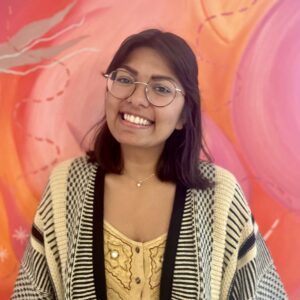 Juhi Gupta, Digital Media Specialist
Juhi Gupta, Digital Media Specialist
